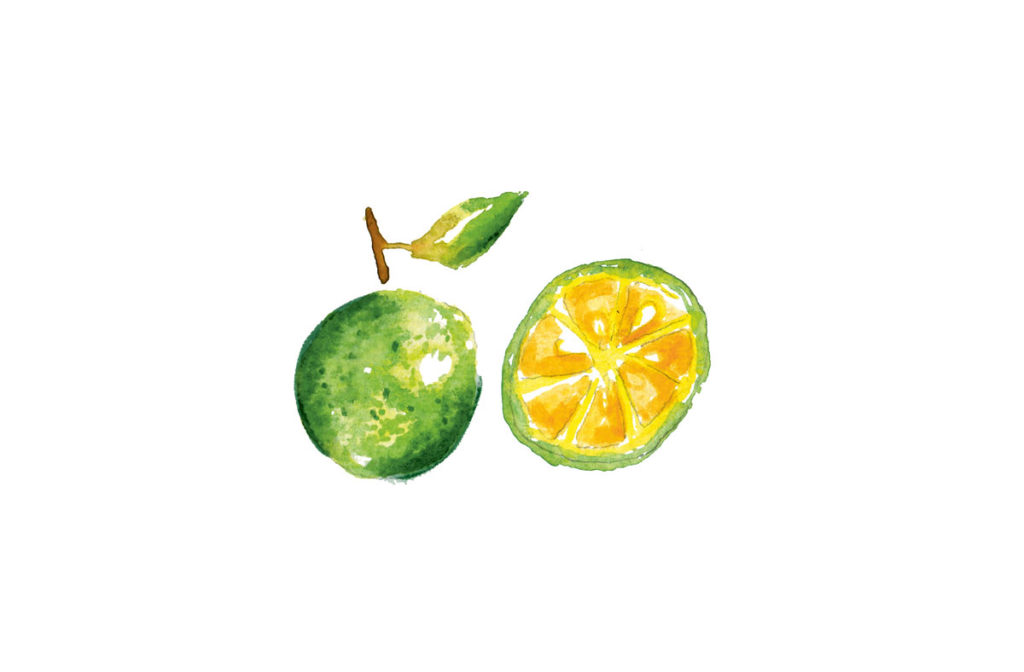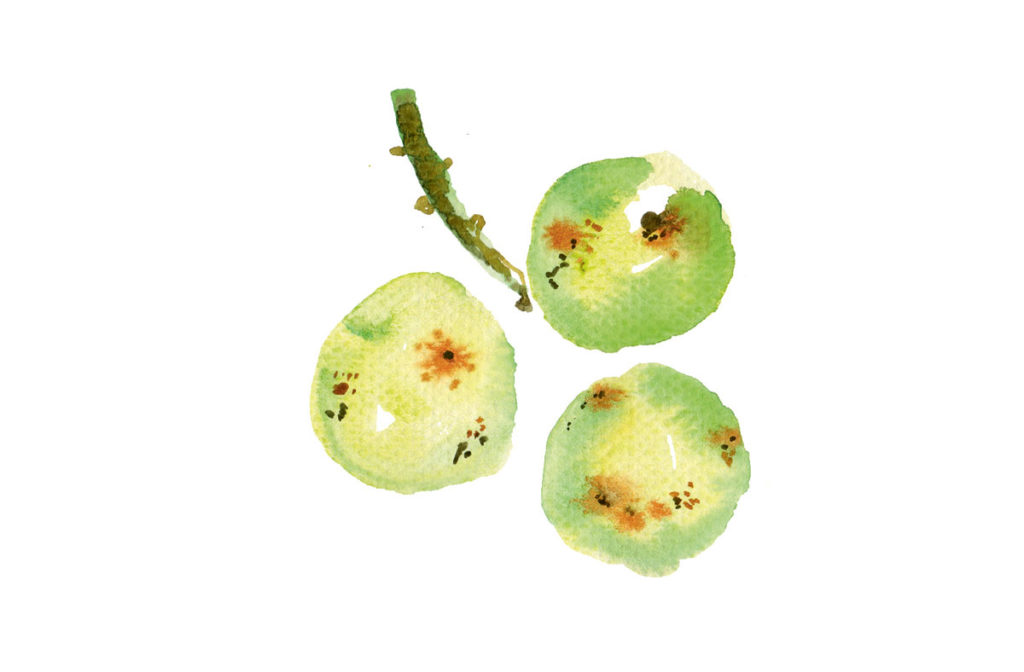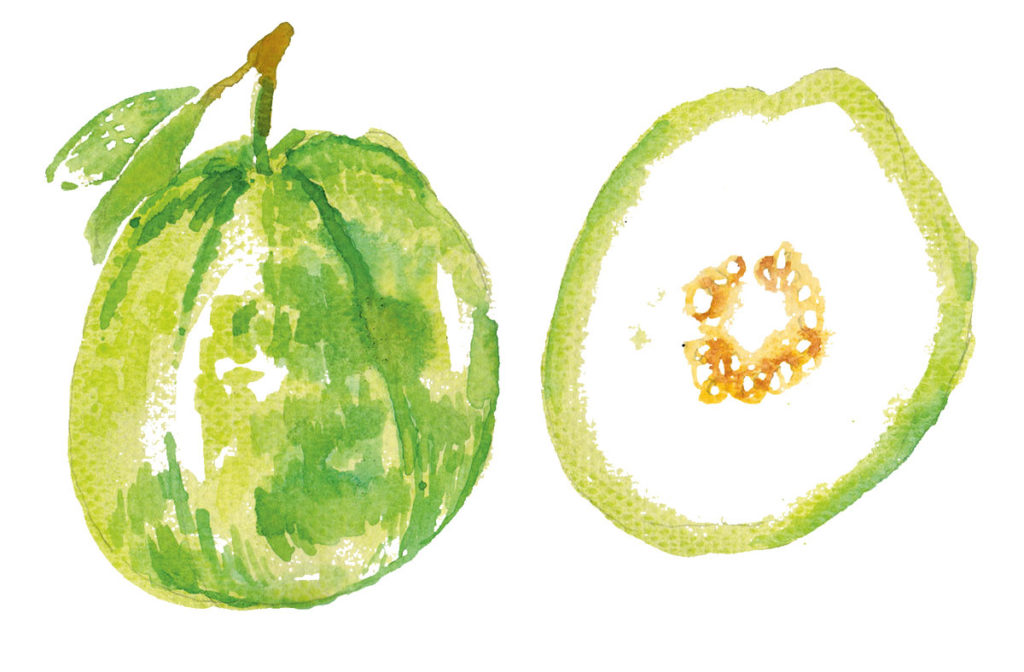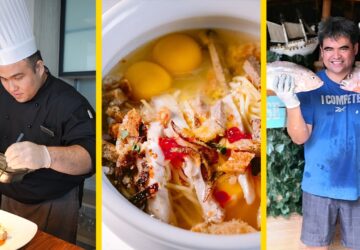We wince like we are in pain. Our faces portray discomfort as if we were elbowed in the rib or an icy drink agitated a sensitive tooth. Then gradually, almost indulgently, that pained grimace is slowly replaced by a satisfied smile.
That’s our typical face when we have a mouthful of sour—a bite of stinging kamias; a slurp of warm sinigang na sampalok; the jolting acidity of sinamak. The flavor usually associated with the unripe—or worse, rancid—sour in the Filipino consciousness is associated with good eating.
For instance, while the rest of the world celebrates the sweet flesh of our ripe mangoes, the tangy crunch of green mangoes is just as prized, especially when dipped in bagoong na alamang or as an icy shake.
Adobo, arguably the Philippine national dish, may be cooked in different ways in every household. The protein varies according to preference and availability; even vegetables are welcome options. Adobo may be seasoned with either fish or soy sauce; with or without onions (garlic is another constant); thickened with coconut milk or slightly sweetened with sugar. You may improvise as you wish, but adobo must always be simmered in vinegar. It just would not be adobo without that tang.
Acerbic qualities

So where does this love for sour things come from? Chef and author of “Philippine Cookery: From Heart to Platter” Myke “Tatung” Sarthou has a historical explanation. “I think our penchant for sour flavors evolved from our interaction with nature. Perhaps, our forefathers, having started off as foragers, often picked fruits, many times unripe and sour, and developed a liking for the flavors. Leaves, on the other hand, are either bitter, sour, or grassy. Sour would seem to be the most appealing (of the three). The tropical climate, too, is suitable for fermentation, which also leads to the creation of sour flavors.”
He further explains how, during the American occupation of the Philippines, acidic substances such as vinegar, due largely to its antiseptic and antibacterial properties, were used to sterilize food.
“Food safety was one of the issues that the Americans dealt with when they colonized the Philippines. A lot of Filipinos were dying of cholera, dysentery, malaria, and the like. Food and water was said to be the carrier of some of the bacteria and viruses that spread. In an effort to resolve these health woes, food safety became the focus of the program through home economics.”
He notes that, up to this day, what we consider fiesta food—stews, those cooked in the early hours of the day and in monstrous amounts and made to stand at room temperature as they await consumption by merrymakers—is cooked with a dose of vinegar just to ensure it stays safe to eat even when exposed to the elements.
Our love for sour flavors may not define Filipino cuisine but it does illustrate an understanding of complex layers of taste.
Book designer and food writer Guillermo “Ige” Ramos likes to think that our penchant for sour flavor comes from somewhere more primal. “It’s probably the warm weather and the humidity. When you eat something hot and sour, like sinigang, you will sweat and it helps you cool down.” Essentially, eating sour food makes us physically feel better, giving us welcome reprieve from the harsh tropical climate.
Ramos offers us a list of the country’s favorite souring agents, which Sarthou has categorized as “vinegars, fruits, and leaves.” From Luzon, and enumerated from sour to sourest, are guava, tomato, catmon, tamarind, calamansi, kamias, and mango. There’s batwan, a hard, green fruit smaller than a lime in Western Visayas. And we use vinegar in the preparation of kinilaw, paksiw, and adobo, and calamansi for pancit.”
Sarthou cautions that levels of tanginess do vary and are never constant. “Sourness really depends on the specific quality of the products used. Thus, it is wise to taste them first before adding.”


Balancing act
While there are those like Sarthou’s grandfather who is quite the vinegar connoisseur and slurps the stuff like soup, Ramos admits that, for most people, there is a need to counteract the jaw-clenching tang.
“In Southern Tagalog, particularly in Cavite,” where Ramos is from, “we like sour food like adobo and sinigang. But there’s always a counterpoint or taste balancing. For adobo cooked with vinegar and patis or toyo, we would normally eat ripe, sweet banana with it, like lakatan or latundan. And to counteract the sourness of sinigang, we would have a salty condiment like patis.”
Both attest that sour is rarely the central flavor of any dish but offers a stark contrast. Sometimes, it’s used as a clean background to allow bolder and potentially more pleasing flavors to shine. Sarthou uses sourness to “bring out the freshness” of a dish, while Ramos acknowledges how “psychologically, sour food makes (a dish) clean tasting.”
Whether it’s a backdrop or focal point, sour flavor is something Filipinos have learned to harness the eclectic qualities of. After all, we are masters of sawsawan, condiments that distinctly appeal to our preferences in flavors. “So when one cooks,” Sarthou imparts, “it can be assumed that he or she has already been introduced to the idea of mixing and matching elements of a meal to create what they perceive to be masarap.”

Claim to fame
But just because we know how to wield sourness like a gastronomic wand, does that make it ours? And is it a flavor that can set our cuisine apart from others?
Distinguished cookbook author and restaurateur Amy Besa, in a National Geographic article entitled “Power of Sour in Manila,” proclaims with much finality: “Sourness is the main flavor that distinguishes us from other Asian cuisines.” Though very few would even dare dispute that, the pronouncement is indeed riddled with holes.
For one, the penchant for sour is not limited to the archipelago. In Western countries, acidic flavors are almost exclusive to condiments (vinegars, mustards, and pickled vegetables such as cornichon and sauerkraut), although Mediterranean flavors seem to favor it. What would Italian food be like without the fresh zing of tomatoes? Greek salads and meats gain extra vibrance with a brisk squeeze of lemon. “China and Thailand have their own sour food,” Ramos points out that and Sarthou looks to his historical research to prove a point.
“Traditionally people in Vis-Min did not eat sinigang. That’s a Luzon dish. What we had was tuwa or tinuwa (or tinola, as its commonly known in Luzon), which was only very mildly sour. It was only when powdered sinigang mixes became popular that it slowly caught on in those areas,” says Ige Ramos.
“Traditionally people in Vis-Min did not eat sinigang. That’s a Luzon dish. What we had was tuwa or tinuwa (or tinola, as it’s commonly known in Luzon), which was only very mildly sour. It was only when powdered sinigang mixes became popular that it slowly caught on in those areas.”
Filipino food, because of its highly regional nature in terms of flavors and ingredients, has always been notoriously difficult to define. Ramos adds: “It is a Tagalog or Kapampangan thing when it comes to sinigang and adobo and kinilaw for Visayas. The humba of Cebu and Samar is not as sour as the Tagalog or Kapampangan adobo. The food in Mindanao is not that sour at all. And same in Bicol.”

As much as it would be easy to anoint sour as the defining element of Filipino dishes, it seems that its influence over our cuisine is not even encompassing enough to define more than half of the territory. “We can’t really assume that all soured dishes are distinctively Pinoy, regional, yes, but not the entire country,” Ramos states.
Our love for sour and acidic flavors may not define Filipino cuisine but it does illustrate an understanding of complex layers of taste. There is that simple scientific know-how, that practicality of making food edible for a longer period of time as well as the manipulation of taste to enhance the eating experience.
Although mostly brought about by unfortunate circumstances (humidity rendering cooked food rancid; spread of disease through unsanitary food and water), it is that Filipino resilience and make-do attitude that render our dishes unique.
Originally published in F&B Report Vol. 14 No. 1





